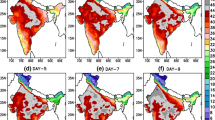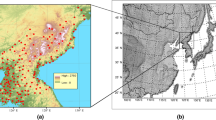Abstract
The output from Global Forecasting System (GFS) T574L64 operational at India Meteorological Department (IMD), New Delhi is used for obtaining location specific quantitative forecast of maximum and minimum temperatures over India in the medium range time scale. In this study, a statistical bias correction algorithm has been introduced to reduce the systematic bias in the 24–120 hour GFS model location specific forecast of maximum and minimum temperatures for 98 selected synoptic stations, representing different geographical regions of India. The statistical bias correction algorithm used for minimizing the bias of the next forecast is Decaying Weighted Mean (DWM), as it is suitable for small samples. The main objective of this study is to evaluate the skill of Direct Model Output (DMO) and Bias Corrected (BC) GFS for location specific forecast of maximum and minimum temperatures over India. The performance skill of 24–120 hour DMO and BC forecast of GFS model is evaluated for all the 98 synoptic stations during summer (May-August 2012) and winter (November 2012–February 2013) seasons using different statistical evaluation skill measures. The magnitude of Mean Absolute Error (MAE) and Root Mean Squared Error (RMSE) for BC GFS forecast is lower than DMO during both summer and winter seasons. The BC GFS forecasts have higher skill score as compared to GFS DMO over most of the stations in all day-1 to day-5 forecasts during both summer and winter seasons. It is concluded from the study that the skill of GFS statistical BC forecast improves over the GFS DMO remarkably and hence can be used as an operational weather forecasting system for location specific forecast over India.
























Similar content being viewed by others
References
Attri S D, Pandey A B and Dubey D P 1995 Forecasting of minimum temperature over Gangtok; Mausam 46 63–68.
Bhardwaj R, Kumar A, Maini P, Kar S C and Rathore L S 2007 Bias-free rainfall forecast and temperature trend-based temperature forecast using T-170 model output during the monsoon season; Meteorol. Appl. 14(4) 351–360.
Bhardwaj R, Kumar A and Maini P 2009 Evaluation of bias free rainfall forecasts and Kalman filtered temperature forecasts of T-80 model over Indian monsoon region; Mausam 60(2) 147–166.
Chakraborty T K 2006 Prediction of winter minimum temperature of Kolkata using statistical model; Mausam 57 451–458.
David F P. and John C D. 1992 The National Meteorological Center’s Spectral Statistical-Interpolation Analysis System; Mon. Wea. Rev. 120 1747–1763.
Dimri A P, Mohanty U C, Ravi N, and Madan O P 2002 Statistical model-based forecast of minimum and maximum temperatures at Manali; Curr. Sci. 82 997–1003.
Dimri A P and Mohanty U C 2007 Location specific prediction of maximum and minimum temperature over the Western Himalayas; Meteorol. Appl. 14 79–93.
Dimri A P, Joshi P, and Ganju A 2008 Precipitation forecast over western Himalayas using k-nearest neighbour method; Int. J. Climatol. 28 (14) 1921–1931.
Durai V R and Roy Bhowmik S K 2013 Prediction of Indian summer monsoon in short to medium range time scale with high resolution global forecast system (GFS) T574 and T382; Clim. Dyn., doi:10.1007/s00382-013-1895-5.
Glahn H R and Lowry D A 1972 The use of Model Output Statistics (MOS) in objective weather forecasting; J. Appl. Meteor. 11 1203–1211.
Hart K A, Steenburgh W J, Onton D J, and Siffert A J 2004 An evaluation of mesoscale-model-based model output statistics (MOS) during the 2002 Olympic and Paralympic Winter Games; Wea. Forecasting 19 200–218.
Kalman R E 1960 A new approach to linear filtering and prediction problems; Trans. ASME–J. Basic Eng. 82 35–45.
Kalnay M, Kanamitsu, and Baker W E 1990 Global numerical weather prediction at the National Meteorological Center; Bull. Am. Meteor. Soc. 71 1410–1428.
Kanamitsu M 1989 Description of the NMC global data assimilation and forecast system; Wea. Forecasting 4 335–342.
Kanamitsu M, Alpert J C, Campana K A, Caplan P M, Deaven D G, Iredell M, Katz B, Pan H -L, Sela J, and White G H 1991 Recent changes implemented into the global forecast system at NMC; Wea. Forecasting 6 425–435.
Kleist, Daryl T, David F P., John C D., Russ T., Wan-Shu W., and Stephen L. 2009 Introduction of the GSI into the NCEP Global Data Assimilation System; Wea. Forecasting 24 1691–1705.
Krishnamurti T N, Sanjay J, Mitra A K, and Vijay Kumar T S V 2004 Determination of forecast errors arising from different components of model physics and dynamics; Mon. Wea. Rev. 132 (11) 2570–2594.
Joensen A, Giebel G, Landberg L, Madsen H, and Nielsen H 1999 Model output statistics applied to wind power prediction; Proceedings of the European Wind Energy Conference, Nice, France, pp. 1177–1180.
Landberg L 1994 Short-term predictions of local wind conditions; Ph.D. thesis, Riso National Laboratory, Denmark.
Maini, Parvinder, Ashok K., Rathore L S, and Singh S V 2003 Forecasting maximum and minimum temperatures by statistical interpretation of numerical weather prediction model output; Wea. Forecasting 18 938–952.
Mao Q, McNider R T, Mueller S F, and Juang H -M H 1999 An optimal model output calibration algorithm suitable for objective temperature forecasting; Wea. Forecasting 14 190–202.
Mass C F, Ovens D, Westrick K, and Colle B A 2002 Does increasing horizontal resolution produce more skillful forecasts? The results of two years of real-time numerical weather prediction over the Pacific northwest; Bull. Am. Meteor. Soc. 83 407–430.
Moorthi S, Pan H L and Caplan P 2001 Changes to the (2001) NCEP operational MRF/AVN global analysis/forecast system; NWS Technical Procedures Bulletin 484 14p, http://www.nws.noaa.gov/om/tpb/484.htm.
Mohanty U C and Dimri A P 2004 Location specific prediction of probability of occurrence and quantity of precipitation over western Himalayas; Wea. Forecasting 19 (3) 520–533.
Raj Y E A 1989 Prediction of winter minimum temperature of Pune by analogue and regression method; Mausam 40 175–180.
Saha, Suranjana and Coauthors 2010 The NCEP Climate Forecast System Reanalysis; Bull. Amer. Meteor. Soc. 91 1015–1057, doi:10.1175/2010BAMS3001.1.
Singh D and Jaipal 1983 On forecasting night minimum temperature over New Delhi; Mausam 34 185–188.
Steed R C and Mass C F 2004 Bias removal on a mesoscale forecast grid. [Available online from http://www.mmm.ucar.edu/mm5/workshop/ws04/Session2/Steed.Rick.pdf].
Stensrud D J and Skindlov J A 1996 Grid point predictions of high temperature from a mesoscale model; Wea. Forecasting 11 103–110.
Stensrud D J and Yussouf N 2005 Bias-corrected short-range ensemble forecasts of near surface variables; Meteorol. Appl. 12 217–230.
Wilson L J and Vallèe M 2002 The Canadian updateable model output statistics (UMOS) system: Design and development tests; Wea. Forecasting 17 206–222.
Woodcock F and Engel C 2005 Operational consensus forecasts; Wea. Forecasting 20 101–111.
Acknowledgements
Authors are thankful to Guru Gobind Singh Indraprastha University for providing research facilities. Also, authors are grateful to the Director General of Meteorology and Deputy Director General of Meteorology (NWP Division), India Meteorological Department for their encouragement and support to complete this research work. Acknowledgements are due to NCEP, USA for providing the source codes and NCMRWF for technical support for the implementation of the upgraded version GFS T574 at IMD.
Author information
Authors and Affiliations
Corresponding author
Rights and permissions
About this article
Cite this article
Durai, V.R., Bhardwaj, R. Location specific forecasting of maximum and minimum temperatures over India by using the statistical bias corrected output of global forecasting system. J Earth Syst Sci 123, 1171–1195 (2014). https://doi.org/10.1007/s12040-014-0457-5
Received:
Revised:
Accepted:
Published:
Issue Date:
DOI: https://doi.org/10.1007/s12040-014-0457-5




